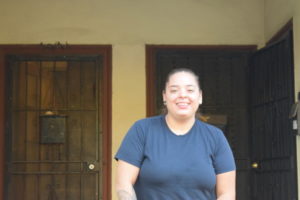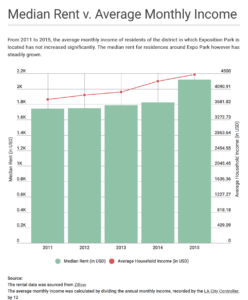Luis Herrera lives with his 82-year-old father in a rented 1-bedroom apartment right opposite the Union Avenue Elementary School on South Burlington Avenue. Herrera works full-time at a credit union in downtown Los Angeles, around two miles from his home.
After moving from another apartment building nearby, the Herreras were settling into their new home. But that sense of comfort was short-lived. After a series of gradual rent increases every year, the owners of the property, the “1979 Ehrlich Investment Trust”, suddenly hiked the rent by nearly 25 percent.
The Herreras are not alone. Across the 192 housing units owned by the Trust in the Burlington Apartments, residents of every single unit have reported an increase in rent by 25 to 50 percent this year, according to activists from the local chapter of the Los Angeles Tenants Union.
According to real-estate website Zillow, the average rent in Los Angeles has steadily risen to nearly $3000 per month in the last five years. Nearly 2 million residents of the county spend more than half their monthly salary on rents.
Herrera moved into his Burlington apartment four years ago and remembers that the rent was initially $850 per month but the contract said that it would increase by $100 the next year.
“It was okay for me because we were moving from another building where the rent had gone up to $1200…So when we moved from that place, you know, $850 sounded a lot better,” said Herrera.
In 2015, Herrera’s rent increased to $950 and then to $1045 the next year. This year, the owners notified him of a further increase to $1300. Herrera earns a little more than $2500 every month. He said that he already spends half his salary on just the rent.
Herrera’s precarious financial position is compounded by the fact that his father needs regular dialysis. Although the dialysis is paid for by Medicaid, sometimes emergencies crop up which further add to Herrera’s financial burden.
“We have a limited amount of subsidies for housing in this country, which means that most people, even most poor people rent housing on the private market,” said Michael Lens, a professor of urban planning and public policy at UCLA. “Generally speaking, in Los Angeles, we do need more housing.”
What is the state of the private market when it comes to housing?
According to Zillow, the median rent for a 1-bedroom apartment in the neighborhood in which Herrera’s flat is located is $2,370. The last recorded monthly median household income in the council district was $3,647.
Even in 2015, when the incomes for the council district was surveyed, the rent was around two-thirds that of the household income.
“I know how to spend my money, but it’s really hard when even…if you make, you know, say $2500 a month, when $1300 out of that money is going to rent,” said Herrera.
Besides the rent, Herrera budgets $300-$400 for his food but he says that it usually exceeds the amount because on days that his father is hospitalized, he has to rush from his work to the hospital leaving him no time to cook his own food and forcing him to eat outside.
He also has to pay $300 more every month for his car. His monthly expenditure on gas is around $80. Herrera said that although he works nearby and can easily walk to work, having a car is essential because of his father’s medical condition.
Around $150 more goes on his phone and internet connection and some more on electricity and gas. The result? Herrera hardly has any money left as savings.
Herrera said that many of his neighbors have been forced to move out or have had to take up multiple jobs, sometimes working for 18-20 hours a day, just to be able to pay the rent. Many of his neighbors are old and on fixed incomes from retirement funds and they won’t be able to pay rent if it keeps increasing at the present rate, he said.
Families are also hesitant to move because their children study at the Union Avenue Elementary School right across the street. Herrera said that he knows people in the buildings who are looking for a third job or women who had been taking care of their kids at home and running the house now going out to look for jobs.
“If it comes to it, I can sleep in my car and then I rent a place just for him [Herrera’s father]. I can go to the place, take a nap and just sleep in my car at night…That’s how far I’m willing to go,” said Herrera. He said that his father’s illness has prevented him from moving somewhere else.
A similar situation is faced by Elyse Valenzuela, a resident of a cluster of rent stabilized apartments right opposite the new Banc of California Stadium on Exposition Park. The buildings have been bought by an Irvine-based real estate company, the Ventus Group, and are slated to be demolished to make way for a multi-use luxury residential-cum-commercial complex.
What worries Valenzuela the most about her impending eviction is how her brother, who is disabled and suffers from cerebral palsy, will adapt to a new life in another neighborhood.
“It is going to be hard for him because he has his whole life established here…All of his programs are down the street. We have been going to the same doctor for years,” she said. If they are forced to move somewhere else Valenzuela’s family would also have to consider whether there are good programs for him and good doctors in the new neighborhood.
“The development will generate significant tax revenue for the City of Los Angeles, which will help to provide more city services,” said Alice Walton, a spokesperson for the group.
The developers also plan to set aside 82 of the 186 residential units in the project as “affordable housing” units, available for households making less than 80 percent of the area median income determined by the Department of Housing and Urban Development. Maria Ochoa, a local activist however pointed out that even if the project included housing units at lower prices, the demolition of the existing buildings still means that 32 units are off the market.
“[If] say the whole building was rent controlled and turned over into affordable housing, that would be super helpful to the community,” she said.
Valenzuela’s apartment falls under Council District 9, where the median household income is among the lowest in the county. The district has among the highest unemployment rates in the city (8.5 percent unemployed). More than a quarter of the households are also enrolled in the Supplemental Nutritional Assistance Program — the highest in the city.
The planned commercial project is part of a surge in gentrification around the University of Southern California which adjoins Exposition Park. the university’s growing international cohort also show a willingness to pay more — a fact developers and property owners wish to cash in on. Last month, for instance, around 80 tenants at an apartment complex off Exposition Boulevard were evicted because the new owners plan to convert the units into student housing.




Leave a Reply
You must be logged in to post a comment.